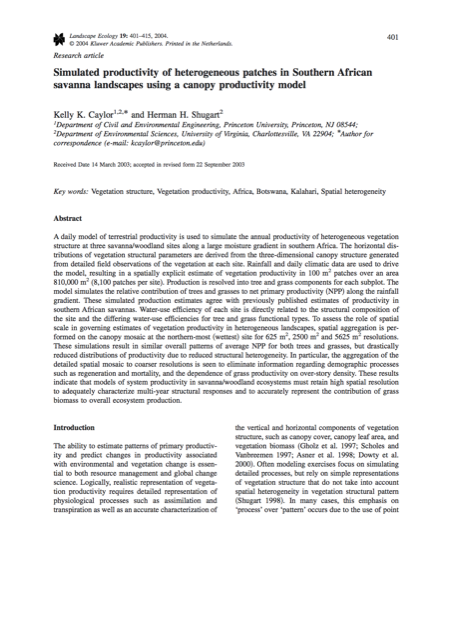Simulated productivity of heterogeneous landscape patches in southern African savanna landscapes using a canopy productivity model

Caylor, K.K., H.H. Shugart (2004) “Simulated productivity of heterogeneous landscape patches in southern African savanna landscapes using a canopy productivity model.” Landscape Ecology, 19(4):401-415.
A daily model of terrestrial productivity is used to simulate the annual productivity of heterogeneous vegetation structure at three savanna/woodland sites along a large moisture gradient in southern Africa. The horizontal distributions of vegetation structural parameters are derived from the three-dimensional canopy structure generated from detailed field observations of the vegetation at each site. Rainfall and daily climatic data are used to drive the model, resulting in a spatially explicit estimate of vegetation productivity in 100 m(2) patches over an area 810,000 m(2) (8,100 patches per site). Production is resolved into tree and grass components for each subplot.
The model simulates the relative contribution of trees and grasses to net primary productivity (NPP) along the rainfall gradient. These simulated production estimates agree with previously published estimates of productivity in southern African savannas. Water-use efficiency of each site is directly related to the structural composition of the site and the differing water-use efficiencies for tree and grass functional types. To assess the role of spatial scale in governing estimates of vegetation productivity in heterogeneous landscapes, spatial aggregation is performed on the canopy mosaic at the northern-most (wettest) site for 625 m(2), 2500 m(2) and 5625 m(2) resolutions.
These simulations result in similar overall patterns of average NPP for both trees and grasses, but drastically reduced distributions of productivity due to reduced structural heterogeneity. In particular, the aggregation of the detailed spatial mosaic to coarser resolutions is seen to eliminate information regarding demographic processes such as regeneration and mortality, and the dependence of grass productivity on over-story density. These results indicate that models of system productivity in savanna/woodland ecosystems must retain high spatial resolution to adequately characterize multi-year structural responses and to accurately represent the contribution of grass biomass to overall ecosystem production.
